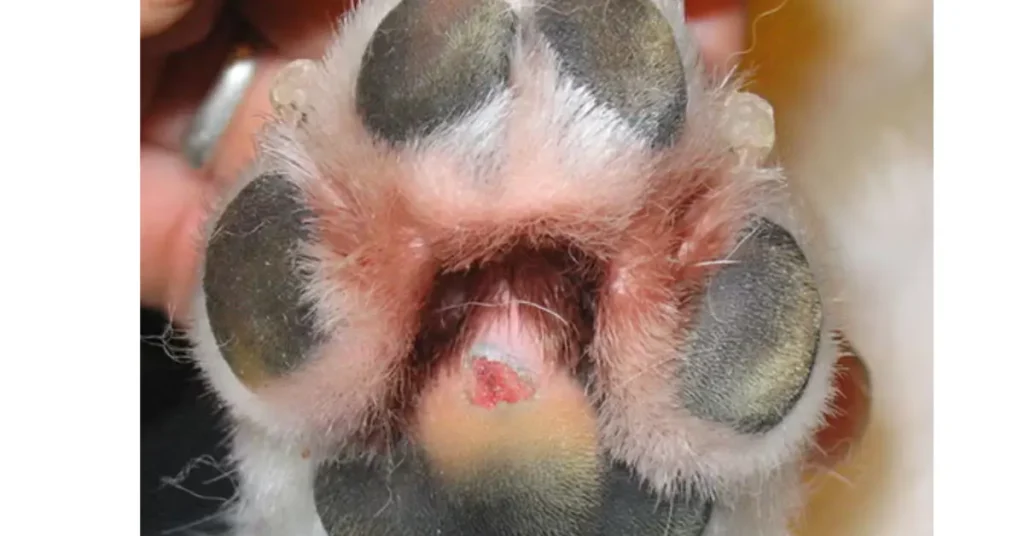What Is Frostbite in Dogs?
Frostbite is tissue damage caused by excessive cold. It occurs when blood flow to the affected area is drastically reduced, leading to injuries similar to thermal burns. The signs of frostbite in dogs often appear when the body’s natural response to cold redirects blood flow away from the extremities to protect vital organs like the heart. This protective mechanism helps maintain core body temperature, but puts areas like ears, paws, and tails at risk of frostbite.
At ThePetDiary.com, we explain how this mechanism, while life-saving, leaves the extremities, which are less vital to survival, unprotected by the oxygenation and heat provided by blood.
Common Areas Where Dogs Get Frostbite
The most typically affected areas of the body are those furthest from the heart, which include:
- Ear tips
- Tail
- Toes
- Nose
- Scrotum
These regions are also extra uncovered to wind and moisture, which could contribute to and exacerbate the development of frostbite.
Are the Signs of Frostbite in Dogs a Medical Emergency?
Frostbite itself isn’t usually a cause of death, but it can arise at the side of low body temperature, which is often life-threatening. Tissue that is broken by way of frostbite can come to be infected or even gangrenous, which could result in a whole body (systemic) infection.
Because of the likelihood of headaches, if frostbite is suspected, the canine ought to be taken right away to an emergency veterinarian for evaluation and treatment.
How Long Does It Take for Frostbite to Occur?
Frostbite can develop in as little as 15 minutes, or it may take several hours or even days to appear.
The time it takes for symptoms to show can differ depending on the characteristics of the dog, such as the amount and length of fur, age, and overall health.
The temperature, along with exposure to wind and moisture, greatly influences when symptoms begin. In higher elevations, frostbite may develop more quickly due to lower levels of oxygen in the air.
What does frostbite look like? Key Signs of Frostbite in Dogs
Frostbite in dogs is typically identified by changes in the skin color, which is often pale, blue, or gray in the early stages.
Once the affected tissue starts to warm up, it may become swollen, red, and blistered. There may also be a moist discharge. In severe cases, the skin can turn black, which means the tissue has died.
Signs and Symptoms of Frostbite in Dogs

Frostbite in dogs may include:
– Pain when the affected area is touched
– Skin that feels cold and brittle
– Discolored skin is usually pale, blue, grey, or even black
– Swelling and redness once the tissue warms up
– Blistered or ulcerated skin
– Presence of ice around the affected area
– Low body temperature due to accompanying hypothermia
Signs and Causes Every Pet Owner Should Know
Can dogs get frostbite? Yes, frostbite can develop at or below freezing temperatures.
The temperature at which dog frostbite develops varies depending on the traits of the canine, concurrent weather conditions, and the immediate surroundings.
In a smaller, quick-haired canine, the improvement of signs and symptoms is predicted to be just to that of people. When temperatures reach 0°F or below, frostbite on dogs’ paws can begin affecting exposed tissue within as little as half an hour. At 15 ranges underneath zero, it’d take about 15 mins. In windy or wet conditions, frostbite in dogs feet can develop in 30 minutes at 32 degrees Fahrenheit.
Healthy cold-weather breeds like the Siberian Husky are more resistant to frostbite and less likely to be affected at moderate freezing temperatures.
Moisture in the environment, consisting of moist bedding, no longer allows for proper air to go with the flow or warm, making dog foot frostbite much more likely to occur. Similarly, wind inhibits the frame’s capability to retain heat. Higher elevations, which have less oxygen in the air, can affect tissue oxygenation, making frostbite on dogs paws much more likely to develop at warmer freezing temperatures.
Dogs with medical conditions such as diabetes mellitus often have reduced blood circulation, which raises their risk of dog feet frostbite. Very young dogs can’t adjust their body temperature efficiently, so they are also at an increased risk. Very old dogs are likely to have decreased muscle mass, which impacts the frame’s ability to warm itself, making them more liable to frostbite and hypothermia.
If your dogs’ paws are cold, or you notice cold paws in dogs, it may be an early warning sign. Always monitor your dog closely in cold environments.
How Veterinarians Diagnose Frostbite in Dogs: Recognizing the Early Signs of Frostbite in Dogs for Accurate Diagnosis
Frostbite is typically recognized based on bodily examination findings. A low body temperature and discolored or dead tissue are two clear signs of frostbite in dogs.
A history of cold exposure, particularly with wet conditions, wind chill, or concurrent illness, can aid a veterinarian in identifying frostbite.
Because frostbite is typically identifiable with facts from a bodily exam and records findings, laboratory assessments are normally not needed for a diagnosis. However, a veterinarian may additionally advise blood assessments to assess for systemic infection or other illnesses that could impair healing. A tradition and sensitivity can be advocated if contamination or tissue lack of lifestyle is present. If the statistics are uncertain or if the arrival of the affected regions is every day, a biopsy can be encouraged.
Treatment of Frostbite in Dogs

If you observe that your canine frostbite, you need to take them to the vet. You need to preserve your canine’s warmth with the car heater and a heat towel. You can gently warm the affected areas with barely warm (no longer warm) water or a moist towel.
It is vital not to rub the skin or attempt to warm it with direct warmth, together as a hairdryer or heating pad, because this can worsen the tissue damage.
Once the vet has tested your dog, they will deal with hypothermia first, if present. They will then slowly reheat the frostbitten tissue. This machine is painful to the canine, so pain medicines might be administered. They will even treat any secondary infections with antibiotics and/or topical antiseptics and prescribe a medicinal drug for pain management.
Severely affected areas might also require surgery to remove nonviable tissue. If a huge region is affected, amputation can be critical. Because it could take days to weeks for the full extent of harm to become apparent, surgical tactics will not be performed at the time of analysis.
Recovery and Management of Frostbite in Dogs
The time frostbite takes to heal is predicated upon the severity of the tissue damage. Mild cases that have blood flow speedily can also heal within a few days.
More intense times will often seem to worsen earlier than they get better, because the quantity of the damage presents itself. This system might also take several days to over every week. Severe instances can also take months to heal, and affected puppies are regularly left with everlasting cosmetic damage.
If the affected tissue has died (become necrotic), it’s going to possibly require surgical intervention. Very severe instances that affect a large amount of skin or deeper tissues may also require amputation.
Prevention of Frostbite in Dogs
Frostbite may be averted by the use of preserving the dog’s extremities in the route of cold weather. Dogs now have to be kept indoors for extended periods while the weather is very cold. If they do spend time outdoors for the duration of bloodless weather, they should have get right of entry to heat, dry bedding in a wind-protected region; but, this ought to be for brief safety only, no longer as an alternative to maintaining the dog indoors. Similarly, canine clothes, which include sweaters and boots, may additionally assist keep puppies heat for brief durations of time, but must not be used instead of retaining dogs indoors.
Conclusion
Frostbite in dogs is a serious condition caused by extreme cold, where blood flow to extremities is reduced, leading to tissue damage. It most often affects areas like the ears, tail, nose, and paws. Prompt veterinary care is crucial to prevent complications like infection or tissue death. Prevention through proper shelter and limiting cold exposure is the best way to protect your dog.
Frostbite in Dogs FAQs
1-At what temperature do puppies get frostbite?
Any freezing or subfreezing temperature can cause dog frostbite.
2-What does frostbite look like on puppies?
Frostbite seems like discolored pores and skin, which can be blue, gray, black, or purple. Affected skin can be blistered and may have a weepy or infected discharge.
3-Can dogs recover from frostbite?
Dogs can get over minor instances of frostbite in a few days. Many instances of frostbite will result in permanent beauty damage. Severe cases can also require medical and surgical intervention. In intense cases, amputation can be essential.


